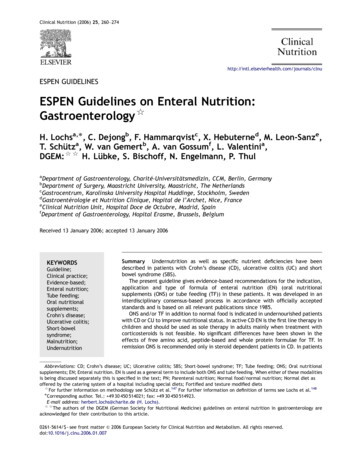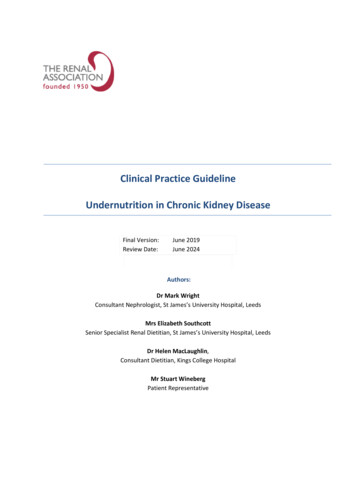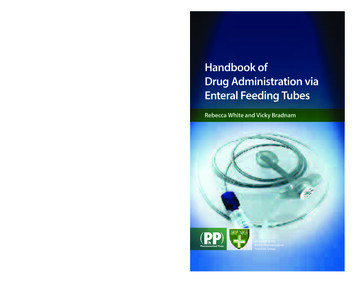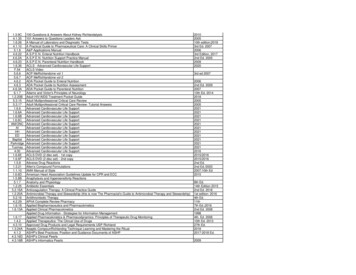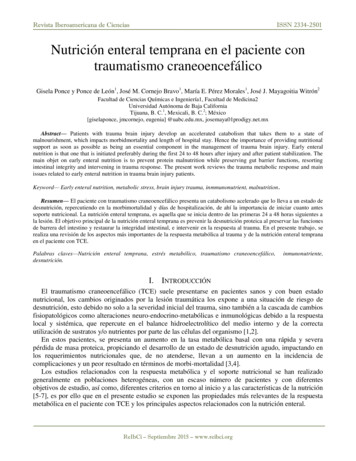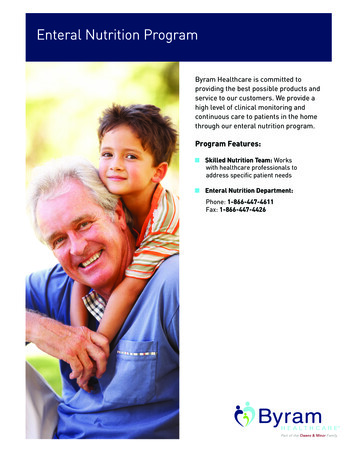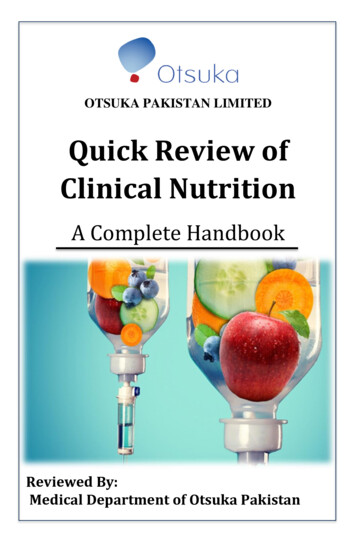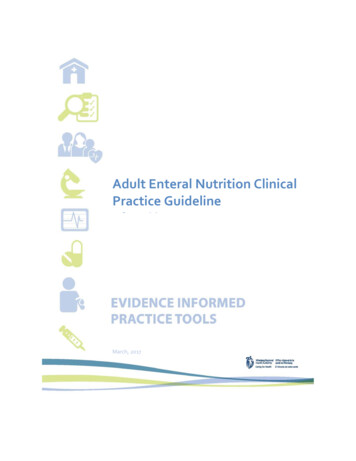
Transcription
Adult Enteral Nutrition ClinicalPractice GuidelineflhMarch, 2017
TABLE OF CONTENTSPurpose and IntentPractice OutcomesPAGE22Indications and Contraindications for Enteral Feeding3Algorithm for Enteral Feeding Administration4Enteral Nutrition Routes of AdministrationReplacement Balloon Gastrostomy TubesLow Profile DevicesSurgical Feeding Gastrostomy/Jejunostomy Tubes6888Enteral Feeding AdministrationMethods of Administration: Continuous, Intermittent, BolusEnteral Feeding ProductsDisease Specific Enteral Feeding ProductsModular Nutrient SourcesWater requirements99101011Initiation and ProgressionHandling and Storage of Tube Feed ProductsMinimizing Bacterial ContaminationTube Feeding General GuidelinesReduce Risk of Pulmonary AspirationGastric Residual VolumesCare of the Patient with Nasal/Oral Feeding Tube/Gastrostomy/JejunostomyTube Stabilization/Maintaining Tube PatencyObstructed Feeding Tubes1111111212131414Medications and Enteral Feeding15MonitoringComplications Associated with Enteral NutritionMechanical ComplicationsGastrointestinal ComplicationsMetabolic Complications16171922Transitional Feeding25Discharge Planning26Appendix A: Enteral & Parenteral Nutrition Formulary Addition RequestAppendix B: Medications and Enteral Feeding Guidelines2733References381
WRHA Adult Enteral NutritionClinical Practice GuidelineThis Clinical Practice Guideline does not replace sound clinical judgment or WRHA site policies, but provides guidanceon best practices for enteral nutrition support for adults.Purpose and IntentEnteral Nutrition (EN) is the provision of nutrients via the gastrointestinal tract, either orally or through a feeding tube.For the purpose of this Clinical Practice Guideline, enteral nutrition will refer to tube feeding (TF).The decision for or against enteral nutrition should be a collaborative decision involving the patient, family/substitutedecision maker, the patient’s physician and other healthcare professionals involved in the care of the patient asappropriate. To promote and facilitate discussions and to support clinical decision-making related to enteral nutrition,please refer to the WRHA Adult Enteral Nutrition – Starting a Collaborative Conversation Clinical Practice /EIPT-034-001.pdfConsideration for patient discharge location is important as mode of feeding/nutrition support may affect options fordischarge from an acute care facility to a long term care facility if that is required.This clinical practice guideline is intended for use in all sectors of the WRHA and provides information relating to theinitiation and monitoring of tube feeding for adults. It is intended as a resource for nurses and a reference for standardsof practice for dietitians, pharmacists, nurses and physicians across the region. For information regarding tube feedingin Pediatrics, refer to WRHA Pediatric Clinical Nutrition manuals.phpPractice Outcomes1. Provide appropriate nutrition support to adult patients.2. If enteral nutrition is used to provide nutrition support, ensure safe initiation and provision of enteral feeding.3. Minimize complications of enteral feeding and standardize practice for addressing any complications that arise.BackgroundThis clinical practice guideline was undertaken initially as a project of the WRHA Nutrition Advisory Subcommittee toupdate/revise the WRHA Adult Enteral Nutrition Manual. It is the work of a multi-disciplinary group of Nutrition Supportspecialists in Dietetics, Nursing, Pharmacy and Medicine.It attempts to integrate the most current research in medical nutrition therapy in order to achieve evidence-basedpractice. The literature was reviewed and updated using scientific and clinical practice journals, manuals and books.Recommendations were therefore made using an evidence-based decision making process. When there was a lack ofliterature, expert opinion was used, based on consensus from the working group members and consultation withregional experts.2
Indications for Enteral FeedingWhen oral intake is inadequate to meet nutritional needs or is contraindicated, and the gastrointestinal tract is at leastpartially functioning, enteral nutrition is preferred to parenteral nutrition (TPN) as the optimal method of nutritionalsupport. Every effort should be made to feed via the gastrointestinal tract. However, when the gut is nonfunctioning/inaccessible or when complete bowel rest is required, TPN is indicated. TPN is not indicated as an optionbased on patient refusal of enteral nutrition option.Enteral nutrition offers advantages over parenteral nutrition in terms of: May enhance immune function, maintain gut flora/integrity/function Ease in establishing feeding route Lower cost of product (TF versus TPN solution) Decreased risk of infection, venous thrombosis, metabolic imbalanceEnteral nutrition is indicated when a patient is unable or unsafe to orally maintain/improve nutritional status:Protein-calorie malnutrition (PCM) or risk of PCM with inadequate oral intake ( 2-5 days)Normal nutritional status with prolonged inadequate oral intake ( 7-10 days) Contraindications to Enteral Feeding perforation of gastrointestinal (GI) tractgastrointestinal ischemia (hemodynamically unstable)complete mechanical bowel obstructioncomplete non-mechanical bowel obstructionhigh output enterocutaneous fistula involving proximal small bowelinability to access GI tractPatient/substitute decision maker consent should be obtained prior to intiating enteral feeding.Nutritional AssessmentConsult the unit clinical dietitian for initial nutritional assessment, recommendations regarding appropriate enteralformula, administration and goal rate as well as ongoing monitoring of nutritional status.The medical order, either written or electronically ordered should specify: Formula requested Initial flow rate, progression of feeding and goal rate Route of administration (e.g. nasogastric (NG), orogastric (OG), jejunal, gastrostomy tube, percutaneousendoscopic gastrostomy (PEG) or PEG-jejunal ) Volume and frequency of free water flushes per 24 hours3
ALGORITHM FOR ENTERAL FEEDING ADMINISTRATIONYou can move directly to specific pages by pressing control and Click on hyperlinks which are theitalicized words in some process/task boxesNutritional AssessmentGastrointestinal Tractcan be safely usedYESNOParenteral NutritionAdequate Intestinal AbsorptionYESNOPolymeric Formula EnteralfeedingproductsChemically Defined Formula EnteralfeedingproductsAt risk for aspirationYESNasoduodenal/jejunal TubeEnteralrouteofadministrationNONasogastric Tube EnteralrouteofadministrationInitiation and Progression of Tube FeedingInitiationandprogressionCheck Gastric residuals in gastrically fedpatient GastricresidualvolumesConsider medications MedicationsandfeedsMonitor patient MonitoringTroubleshoot Complications Complications4
Enteral Nutrition required 6 wksYESNOInsertion of Enterostomy TubeEnteralrouteofadministrationContinue to monitorAdequate nutrient deliveryYESNOSupplemental Parenteral NutritionContinue to monitorHome Tube Feeding/TPN requiredNOYESProcess/Task Decision Consult Manitoba Home NutritionProgram (MHNP)DischargeplanningOR liase with Chronic Care/PersonalCare HomeROUTES OF ADMINISTRATIONThe route for enteral feeding must be individualized. Factors determining the route include the condition of the GI tractand the anticipated duration of feeding. Enteral feeding may be administered by an oroenteric or nasoenteric tube orby an enterostomy tube.5
ENTERAL NUTRITION ROUTES OF ADMINISTRATIONExpected lengthof onsType of tube usedVerifying initialplacement6NASOENTERIC FEEDING1Nasogastric 6 weeksNasoduodenal/nasojejunal 6 weeksENTEROSTOMY FEEDINGGastrostomyJejunostomy/ PEG J 6 weeks 6 weeks Easiest to insert Most physiologic manner of feeding Continuous or intermittent Indicated if not tolerating gastric feeds. PEG is non-surgical Complete obstruction of GI tract above or Obstruction of GI tract above or belowbelow stomach Severe reflux Facial or cranial trauma Caution with esophageal varices8-14 FR8-12 FRPolyurethanePolyurethane DEHP freeDEHP freeWeightedNon-weightedWith or without radiopaquetipstylet (facilitates tubeInserted onpassage)ward by nurseGreater patient comfortor physicianReduced risk of aspirationNormalInserted on ward by nurseinsertion length or physician50-60 cmNormal insertion length 50Can be in place 60 cmCan be in place for up to 30for up to 30daysdaysAbdominal xray is gold standard2Aspiration of abdominal contentsRecommended length from nares to end offeeding tube 50-60 cmImpaired gastric emptying or high riskfor reflux and aspirationduodenum Intolerance to small bowel feedingsTube placement more difficult; optimalthplacement is 4 portion of duodenum orpast ligament of Treitz8-12 FRPolyurethane DEHP freeWeighted or nonweighted tipRadiopaque stylet to facilitate tubepassageNormal insertion length 80 cm to passbeyond pylorusInsert in radiology, endoscopy suite or atbedside by nurse or physician trained inproper techniqueAbdominal xray MUST BE DONE if notinserted under videoflouroscopyprocedure so ispreferred to surgicalgastrostomy Allows feeding ifnasal intubation notpossible e.g.esophagealobstruction Complete obstructionof GI tract belowstomach12-28 FR silicone DEHPfreeInserted in OR,endoscopy suite orbedside withendoscopeExtend 30-38 cm fromskin with a cap or plugKept in place withcross-piece, tubing,bolster, externalbumper or retentiondisk. Life span of PEGtube 1-2 yearsConfirmed anddocumented byphysician at time ofprocedure Allows feeding when upper GItract not functional but normalsmall bowel function Distal intestinal obstruction8-12 FR passed over a guide wireinto small bowel throughpreviously placed PEGConfirmed and documented byphysician at time of procedure
Ongoingverification1NASOENTERIC FEEDINGNasogastricMeasure external tube length from nares toend of feeding tube every shift;Observe aspirates: gastric are grassy green,brown, clear to off-white mucous or sediment,intestinal are light to dark golden yellow orbrownish-green; respiratory are watery, strawcoloured or mucous with or without streaks ofbright red bloodNasoduodenal/NasojejunalMeasure external tube length from noseto end of feeding tube every shiftENTEROSTOMY FEEDINGGastrostomyMark tube where itexits and measureexternal length q shift;check placementroutinely duringcontinuous feeds,before intermittentfeeds, duringmedicationadministration orirrigationJejunostomyMark tube where it exits andmeasure external length everyshift; check placement routinelyduring continuous feeds, beforeintermittent feeds, duringmedication administration orirrigation:Orogastric tubes are used in specific areas, primarily in the Intensive Care Units. Other units primarily provide nasogastric tube feedings.2Aspiration of abdominal contents:pH measurement of contents aspirated from pre-pyloric feeding tube is only valid if stomach empty for 4-6 hours and is invalid if antacids have been usedrange of pH valuesgastric fluid0-5lung fluid 6Do NOT aspirate if small bowel feeding tube usedAdapted from Perry AG, Potter DA, Ostendorf WR. 2014. Clinical nursing skills and techniques, 8th edition in Mosby Skills, Nursing Skills Onlineaccessed May 14, 2015.Once the tube position is confirmed the tube should be securely anchored to the nose using skin protectant and Feeding Tube Attachment Device.If displacement of the tube is suspected hold tube feedings; consult physician. In most cases an abdominal x-ray should be done. If acomplication secondary to insertion is suspected (e.g. viscus rupture) a CT may be appropriate; consult physician.DOCUMENTATIONDocumentation of the insertion time, type, size and position of the tube is done by the nurse or physician who inserted the tube.Documentation of the external tube length from nares to end of feeding tube is done by the nurse q shift for nasogastric, nasodoudenal and nasojejunalfeeding tubes.ENFitA new industry design standard for enteral feeding is being adopted to enhance patient safety and prevent tubing misconnections. The ENFit connector willbe phased in for feeding tubes, feeding syringes and feeding administration sets.7
Replacement Balloon Gastrostomy Tubes Refer to site policies and procedures, such 0/120/297.pdfgastrostomy tubes should be replaced when leaking, damaged, malpositioned or irreversibly occludeda replacement balloon gastrostomy tube is usually inserted when the gastrostomy tube tract is well formed andfurther endoscopy is not neededan inadvertently dislodged gastrostomy tube should be replaced as soon as possible because the tube tract canclose within a few hoursduring the maturation process (4–6 weeks), only a physician should insert the replacement tube which isusually performed under fluoroscopy or contrast studyonce the gastrostomy tract is well matured, nurses may insert the replacement tube upon a physician’s order,depending on their knowledge, experience and facility policiesa spare replacement balloon gastrostomy tube should always be available in the facility; replacement tubesshould be the same diameter as the original tubethese tubes are made of silicone and are available in sizes 12-28 FR DEHP-freeLow Profile Devices Refer to site policies and procedures such as ? 4025cosmetically appealing to patients but may also be beneficial to children or confused adults who tend to pull atthe tubemay decrease the likelihood of pyloric obstruction from inward migration of the tubecomposed of an internal and external stabilizer, shaft, connecting tube and an anti-reflux valve to keep gastriccontents from leaking onto the skinmay be used as a replacement device after the stoma tract has healedinitial replacement should be performed by a physicianchoosing the appropriate shaft length is important; if the shaft is too short the patient may develop pressurenecrosis of the skin. If the patient has a change in weight (10 lb/4.5kg weight gain or loss) the shaft length willneed to be reassessed.The gastrostomy tube is made of silicone, DEHP free; PEG made of polyurethaneSurgical Feeding Gastrostomy/Jejunostomy Tubes 8surgical gastrostomy tubes are usually large bore tubes and feedings are started in 24-48 hours once gastricfunction returns (confirmation with the surgical team is recommended regarding initiation of tube feeds)surgical jejunostomy tubes are a smaller bore tube (8-10 FR polyurethane catheters)for replacement of the surgical feeding gastrostomy tubes refer to Replacement Balloon Gastrostomy Tubesfor replacement of the surgical feeding jejunostomy tubes, the physician will need to replace the tube in theendoscopic, radiographic or surgical suite.
ENTERAL FEEDING ADMINISTRATIONMETHODS OF ADMINISTRATIONCONTINUOUSINTERMITTENTBOLUS200 – 500 ml over 15minutes severaltimes/daySyringeYesNoHighestUsual volumedelivered25-150 ml/hr over 1224 hoursDelivered byUsed for gastric feedsUsed for small bowelfeedsRisk for abdominaldistention, aspirationPumpYesYes235-500 ml over 3090 minutes severaltimes/dayPump or GravityYesNoLowHigherENTERAL FEEDING PRODUCTSSelection of the appropriate product is based on the individual patient’s medical condition, nutritional status anddigestive/absorptive capabilities. Due to periodic contract changes, formulas available may change. Composition ofproducts can change; the product label is the best source of information when exact nutrient content is required.TYPE OF PRODUCTPOLYMERICExamplesIsosource VHN, Isosource VHPFibre Free, Isosource HNIntact protein from casein(milk), soySafflower, canola, soy oils(may contain others),medium chain triglycerides(MCT)Maltodextrin, corn syrupsolids, soy polysaccharides(may contain others)Ready to use liquidProtein sourceFat sourceCarbohydrate sourceLiquid/powderOsmolalityFibre containingSuitable for oralsupplementationVitamin K contentLactose ContentGluten Free9CHEMICALLY DEFINED (SEMIELEMENTAL/ELEMENTAL)Vital Peptide 1.0, Vivonex PlusFree amino acids or short-chainpeptidesHigher MCT content than polymeric;also contain safflower, soy oil; someare very low in total fatMaltodextrin, sucrose, cornstarch 300 – 800May or may notYesReady to use liquid, powder forsome 300 - 650Most are low fibreNot usuallyLarger than usual oral intakeLow lactose contentYesLarger than usual oral intakeLow lactose content or lactose freeYes
Disease Specific (Specialty) Enteral Feeding ProductsSpecialty enteral products designed for patients with specific medical conditions that may respond to nutrientmanipulation exist. Within its mandate, the WRHA Nutrition Advisory Subcommittee establishes working groups toexamine the literature for evidence supporting the use of specialty products. The following have been reviewed:A. Disease-Specific: Diabetes/Abnormal Glucose Tolerance and Respiratory Compromise: There is insufficient evidence to support the routine use of low carbohydrate, modified fat formulas fordiabetes (2015) or low carbohydrate, high fat formulas for respiratory compromised patients (2002).B. Disease-Specific: Inflammatory Bowel Disease (IBD): There is insufficient evidence to recommend Modulen IBD over other enteral formulas as nutrition therapyfor inducing remission in IBD (2014)C. Immune Enhancing: Peptamen AF is considered safe for use in most populations; there are some populations that should notbe fed with Peptamen AF and for those it is recommended that the physician be consulted prior to use andcontraindications reviewed.D. Open versus Closed Feeding Systems: There is insufficient evidence to recommend the use of closed systems as superior to open systems withappropriate infection control practices (2014).As new evidence is available, these will be reviewed again and other new products will be reviewed to determinewhether there is sufficient evidence to suggest that a product be recommended for use as nutrition therapy and addedto the WRHA Enteral Formulary. In order for a product to be added to the formulary a WRHA Enteral ParenteralNutrition Formulary Addition Request form must be completed. See Appendix A.Modular Nutrient SourcesProtein, carbohydrate and fat are available in modular form. They can be used to more closely meet a patient’snutritional requirements. When modular products are added to enteral nutrition products they should be added in asterile tube feeding room if added directly or given as a flush if provided at the bedside as per the clinical dietitian’srecommendations.PRODUCTNUTRIENT PROVIDEDRationaleBeneprotein Protein (whey protein isolate)Used when protein needs are not met byenteral product aloneMedium chainFat as MCT oilUsed when patient is unable to hydrolyzeTriglycerides {MCTlong chain fats, has poor mucosaloil)absorption of LCT or defective lymphatictransport of fat; ketogenic dietsPolycal CarbohydrateCarbohydrate/energy supplement (e.g.when patient on protein restricted diet)GlutamineAmino acid glutamineConditionally essential amino acid for 20% total body surface area full thicknessor partial thickness burns10
Water Requirements water requirements are based on the patient’s fluid statusthe volume of water from all sources (i.e. enteral feeding, flushes, intravenous and oral, water given withmeds) should be calculated and measured against requirementswater requirements in a normal, healthy adult are 1 mL/kcalthe amount of additional water needed depends on the free water content and concentration of formulausedo In most commercial tube feeding formulas with caloric densities of1 kcal or 1.5 kcal/mL approximately 80% of the product volume is free watero For products with caloric densities greater than 1.5 kcal/mL approximately 70% of the product volume isfree water.INITIATION AND PROGRESSIONHandling and Storage of Tube Feed Products/Minimize Bacterial Contamination of Tube Feeds Unopened tins/tetra-briks of tube feeding should be stored at room temperature. Stock should be rotated toprevent use of out-of-date products. Discard products that have exceeded manufacturer’s expiration date.Use good hand washing technique when decanting formula and handling delivery sets.Once a tin/tetra-brik is opened, cover unused portion with plastic wrap, label with date and time and store inrefrigerator. Discard all opened containers if not used within 24 hours.Products that require reconstituting should be mixed in a central location (e.g. tube feeding area of kitchen)following food safety procedures.Products reconstituted and/or specially prepared on site are sent to the units in dated containers. Upon arrivalto the nursing unit, refrigerate immediately and until use. If not used within 24 hours, discard.If a patient does not tolerate cold formula, place a measured amount of formula in a lukewarm water bath toremove the chill.Tube Feeding (General Guidelines) 11all tube feedings should be shaken well prior to use.formula should be administered at room temperature. Heating could alter the nutritional composition andcold formula may cause gastric discomfort because the liquid is not warmed by the mouth and esophagus. Ifan intermittent feed needs to be warmed, place a measured amount of the formula in a lukewarm waterbath to remove the chill.fill the container and flush the tubing with the formula to remove the air in the tubing. This prevents excessair from entering the gastrointestinal tract once tube feed is initiated.document the type and volume of formula and the amount of free water given.formula (open enteral system) can be hung safely at room temperature up to 8 hours or as per site policy;hang time for special mixes should not exceed 4 hours.monitor the patient’s tolerance to the tube feeds: bowel sounds, abdominal distention, nausea/emesis,gastric residual volumes, diarrhea, constipation, intake/output, respiratory pattern, daily weight and serumchemistry.notify the physician and dietitian of the patient’s intolerance to the tube feeding.tube feeding bags are dated and changed every 24 hours or as per site policy; cap is attached to pole.
minimize disruption in providing enteral nutrition when patient must be NPO for procedures or tests.Whenever possible and in the best interests of the patient, elective procedures should be prebooked/givenscheduled elective time. The NPO time should be based on the type of procedure, e.g. procedures notinvolving the GI tract such as orthopedic limb and plastic procedures or tracheostomy for a ventilatedpatient may have feeds continue until call to the OR and gastric suctioning done prior to leaving unit IFanesthetist/surgeon agreeable.Reducing the Risk of Pulmonary Aspiration elevate the head of the bed 30 – 45 degrees during tube feeding administration unless contraindicatedmaintain 30 - 45 degree position for 1 hour post intermittent feedingsmonitor for intolerance of tube feeding: nausea/emesis, abdominal distention, increased gastric residuals,abdominal discomfort and decreased bowel soundsadminister tube feeding post pylorus for patients who are at risk for gastric aspirationthe use of dye and other colorants for the purpose of detecting or monitoring potential pulmonaryaspiration is prohibitedthe addition of blue dye to enteral feeds in order to detect pulmonary aspiration is poorly standardized, haslow sensitivity for detecting aspiration and has been associated with deaths in critically ill patients due toabsorption of the colouringSee WRHA y/files/AddofDyetoTubeFeedsMar 000.pdfGastric Residual VolumesThe use of gastric residual volumes (GRV) as a predictor of tube feed intolerance is controversial and may not be basedon physiologically sound information. There is no consensus in the literature on the level of GRV that is considered safewith thresholds ranging from 120-500 mL.GRV should only be checked for patients receiving gastric feeds. Do not aspirate small bowel feeding tubes forresidual volumes.GRV can vary with patient position (supine vs. upright), tube position (antrum vs. fundus), tube type (small bore vs. largebore), size of the aspirating syringe, and method of feeding (bolus vs. continuous).GRV should be considered in the context of the patient’s disease, medications and electrolyte abnormalities which maylead to an ileus or delayed gastric emptying. The risk of aspiration may be increased in patients with trauma or headinjury, altered mental status or those heavily sedated and/or on catecholamines. Prokinetic agents may be useful insome patients.Endogenous secretions should also be considered. Physiologically, it has been estimated that a daily contribution of1500 mL of salivary output and 3000 mL of gastric secretions would generate an average of 188 mL/hr of endogenoussecretions alone in the normally fed adult. In addition, tube feeds may infuse at rates of 25-125 mL/hr. Assuminggastric emptying of 35-50% per hour, GRV may vary 279-464 mL in 4-6 hours. This should be considered in the decisionto hold tube feeds based on GRV. Stopping at low arbitrarily selected volumes may not be clinically appropriate orphysiologically sound.GRV have a low sensitivity as a marker for aspiration. Low GRV does not guarantee tolerance to feeding and a singlehigh GRV does not necessarily predict intolerance because subsequent values may decrease. A trend may be morevaluable than the use of a cut off value. Increases in GRV may precede clinical deterioration or sepsis.12
Monitoring GRV for all patients, as a rule: stop feeding immediately for overt regurgitation and aspirationcheck GRV q4h for continuous feeds or prior to each intermittent feed. Frequency may be reduced oncegoal regime is achieved and tolerance is well establishedif GRV 200 mL (unit patient) or 500 mL (ICU patient), refeed aspirate, continue TF, recheck GRV in 4hoursif GRV 200 mL (unit patient) or 500 mL (ICU patient), discard aspirate, hold TF, notify physicianuse GRV in combination with other assessment parameters.Care of the Patient with Nasal/Oral Feeding Tubes daily inspection of the mouth, nares and pharynx for ulceration, skin irritation, coiled feeding tube, pressurenecrosis and lesions.clean nares daily with warm water.check the tape on the nose or mouth or the fixator device and change every 3-5 days or as needed; pressurenecrosis may occur from incorrect taping.perform oral hygiene q 2 hours.Care of the Patient with a Gastrostomy/Jejunostomy 13for additional information on the procedure 80.120.295.pdffor the first 48 –72 hours the stoma tract is considered an open wound; dressings of drainage sponge orpre-cut gauze are to be placed over the feeding tube/stoma and the skin should be cleansed with sterilenormal saline and dried thoroughly (or as per facility P P).after 48 – 72 hours the healed stoma should be left open to air without a dressing and the skin should becleansed with soap and warm water and dried thoroughly (or as per facility P P).carefully clean under the discs/bumpers/bolsters to keep them dry.observe the skin for signs of infection: foul- smelling drainage, unusual tenderness, swelling or rednesscheck for excessive pressure from the external bumpers and discs; they should be just above the skin level.Skin disc is initially kept tight against abdomen to ensure stomal tract develops. Position of the skin discshould not be adjusted for the first 4 weeks. Monitor position and document q shift.after 4 weeks external bolster should be positioned to allow approximately 0.5 – 1 cm space betweenabdomen and bumper/retention disc when disc is gently pulled up.dressings should not be placed under the external bolster as the dressing may cause the internal bolster toapply pressure to the stomach wall which may force the tube out of the stomach and into the peritoneum.if a dressing is required, only a single layer of gauze should be placed under the bumper/retention disk.After stoma has matured, for balloon and PEG gastrostomy tubes only: rotate tube 360 degrees daily toprevent tube from adhering to sides.do not pinch gastrostomy tubing .if a peristomal wound infection should occur, topical antibiotics (medical order required) may be prescribedor consult nutrition support nurse/wound care specialist. If not improving or more severe infection,systemic antibiotics and/or infectious disease consult may be required.
hypergranulation tissue may develop if the site remains moist and can be eliminated by cauterizing withsilver nitrate sticks (medical order required) or application of hydrocortisone cream 1.0 % twice dailytopically and reassess in 5-7 days. In the home environment, when mild cases of hypergranulation tissue arepresent and the peristomal skin is intact, warm salt water compresses can be used as a less invasivetreatment. To reduce and prevent hypergranulation tissue by this method: Dissolve 1-2 teaspoons of table salt with 120 mL warm water. Soak gauze in warm salt water solution and apply to stoma (hypergranulation tissue) for 5-10minutes, 3-4 times per day for 7-14 days. Solution made should be discarded daily.maintain good oral hygiene.Tube Stabilization (Gastrostomy/Jejunostomy) gastrostomy tubes may have anchor sutures which may be removed once the tract is healed (physicianorder needed to remove the sutures)jejunostomy tubes usually are secured with sutures at all timesif a balloon replacement tube is used, the water in the balloon is to be checked 1 x/weekMaintenance of Feeding Tube PatencyTo ensure tube patency: schedule routine water flushes of the tube (minimum 20 mL for adults) every 4-6 hours for continuousfeedings as well as before and after each intermittent feeding, medication administration and after c
3. Minimize complications of enteral feeding and standardize practice for addressing any complications that arise. Background . This clinical practice guideline was undertaken initially as a project of the WRHA Nutrition Advisory Subcommittee to update/revise the WRHA Adult Enteral Nutrition Manual.

